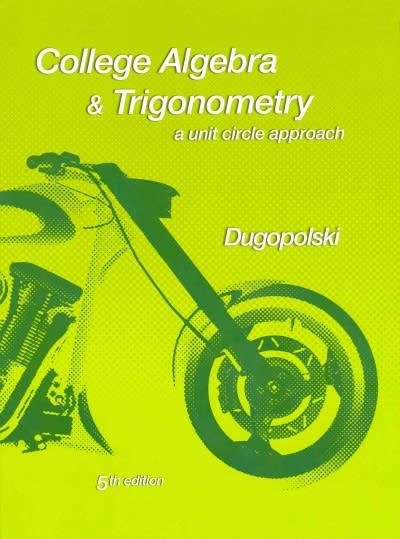Question
sses or contact lenses). Let C = vision correction and P(C) = .75. (1 pt.) (a) If someone is randomly selected, what is the probability
- sses or contact lenses). Let C = vision correction and P(C) = .75. (1 pt.)
(a) If someone is randomly selected, what is the probability that person does not use vision correction? (Find P(C').) Find the probability of not C.
(b) If four different people are randomly selected, what is the probability that they all use vision correction?
(c) Would it be unlikely to randomly select four people and find that they all use vision correction? Why or why not?
Not unlikely or unusual because , probability is greater than 0.05
2.) The two-way table shows the classification of students in a statistics class by age and
dominant hand. A student who is ambidextrous use both hands equally well.
| Right-handed | Left-handed | Ambidextrous | Total | |
| 30 and Under | 11 | 4 | 1 | 16 |
| Over 30 | 12 | 2 | 0 | 14 |
| Total | 23 | 6 | 1 | 30 |
What is the probability that a randomly selected student in the class is over 30 given that
the student is right-handed? (1 pt.)
3.) In a statistics class of 28 students, 13 identified themselves as boys and 15 identified
themselves as girls. On a unit test, 5 boys and 6 girls received a grade of 90-100. If a
student is chosen at random from the class, what is the probability of choosing a girl or
a student with a grade 90-100? (.5 point)
4.) A mathematics teacher has a box of 11 calculators - three that are defective and eight
that are good. If two calculators are selected, what is the probability that both
calculators are defective? (.5 point)
5.) Professor Sopala has invented a new lie-detector machine and is testing it. One
hundred test subjects are told to lie, and the machine catches 80 of them in the
lie. Another hundred test subjects are told to tell the truth, but the machine
nevertheless thinks that 5 of them are lying. (2 pts.)
(a) Draw the tree diagram corresponding to this situation.
(b) Suppose a test subject is chosen at random from the 200, and the machine claims
that he lied. What is the probability that he did in fact lie? Use Bayes' Th.
(c) Suppose a test subject is chosen at random from the 200, and
the machine claims that he told the truth. What is the probability that he did in fact tell
the truth? Use Bayes' Th.
Step by Step Solution
There are 3 Steps involved in it
Step: 1

Get Instant Access to Expert-Tailored Solutions
See step-by-step solutions with expert insights and AI powered tools for academic success
Step: 2

Step: 3

Ace Your Homework with AI
Get the answers you need in no time with our AI-driven, step-by-step assistance
Get Started


